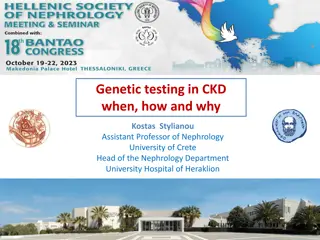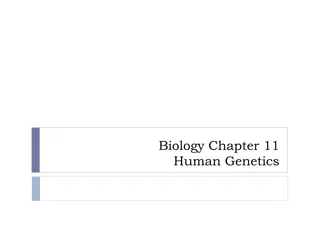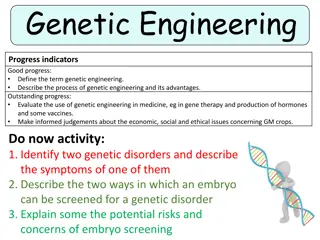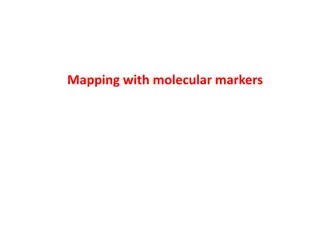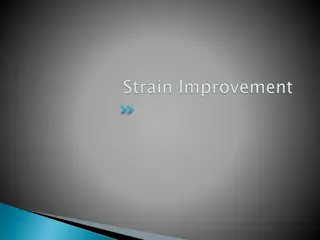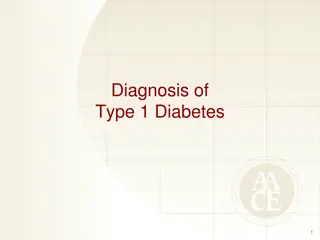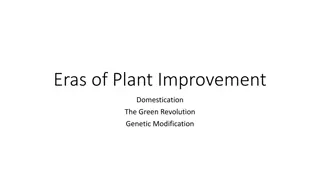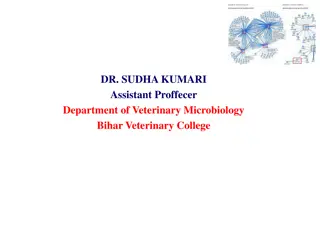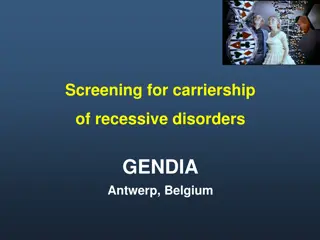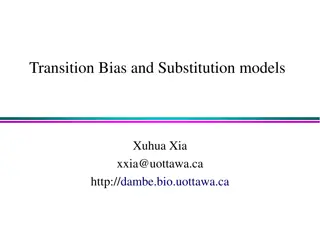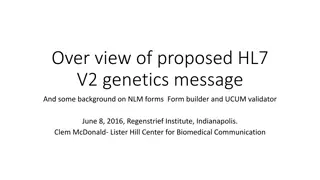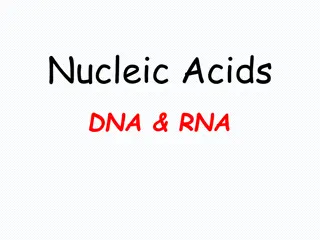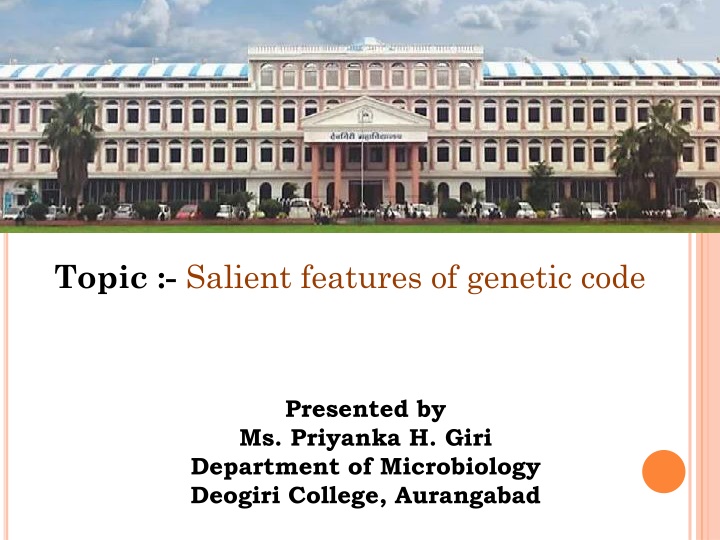
Salient Features of Genetic Code Explained by Ms. Priyanka H. Giri
Explore the salient features of the genetic code presented by Ms. Priyanka H. Giri from the Department of Microbiology at Deogiri College, Aurangabad. Learn about the relationship between DNA/RNA bases and amino acids, the triplet nature of the code, and its degeneracy. Discover the fascinating properties that govern protein synthesis in microbial genetics.
Download Presentation

Please find below an Image/Link to download the presentation.
The content on the website is provided AS IS for your information and personal use only. It may not be sold, licensed, or shared on other websites without obtaining consent from the author. If you encounter any issues during the download, it is possible that the publisher has removed the file from their server.
You are allowed to download the files provided on this website for personal or commercial use, subject to the condition that they are used lawfully. All files are the property of their respective owners.
The content on the website is provided AS IS for your information and personal use only. It may not be sold, licensed, or shared on other websites without obtaining consent from the author.
E N D
Presentation Transcript
Topic :- Salient features of genetic code Presented by Ms. Priyanka H. Giri Department of Microbiology Deogiri College, Aurangabad 1
Microbial Genetics B.SC. IIIRDYEAR SEMESTER VTH PAPER NO. XV MS. PRIYANKA H. GIRI 20/10/2020 UNIT: 2
SALIENT FEATURESOF GENETICCODE:
GENETICCODE: The relationship between the sequence of bases in DNA/RNA and the sequence of amino acids in a polypeptide chain is called the genetic code. The code indicates which codon specifies which amino acid. Amino acids are involved in protein synthesis. About 150 a.a. are found in nature of which only 20 are specified by genetic code. Only these 20 a.a. take part in protein synthesis.
PROPERTIESOFGENETICCODE: 1) Genetic code is triplet: DNA contains four types of nucleotides i.e. A, T, G, and C, and proteins are synthesized from 20 different a.a. The basic problem regarding the genetic code was: How many bases of DNA specify one a.a.? Lets check the probabilities: 1. If a code is singlet, only one base will code for 1 a.a. So, in this case as the bases are only four, that s why only 4 a.a. will be coded. But, we know that 20 a.a. codes for proteins. So here the first probability that is, genetic code is singlet is not possible.
2.If genetic code is doublet, 2 bases will code for 1 a.a. In this case (4X4) 16 a.a. can be coded by 4 bases. 3.If genetic code is triplet, 3 bases will code for 1 a.a. So here, (4x4x4) 64 a.a. can be coded by 4 codons. Which are more than sufficient. A triplet or 3 letter code was first suggested by Physicist Gamow in 1954. This triplet have been called a codon. Out of 64 codons 61 codes for 20 a.a. and remaining 3 are non-sense codons or stop codons.
2) Genetic code is degenerate: Since there are 64 codons and only 20 a.a. so here we can say that one a.a. can be coded by more than one codon. This property is called as degeneracy. Experimental evidences showed that, the code is triplet one and 61 out of 64 codons codes for 20 a.a. and remaining 3 codons doesn t code for any a.a. which are called as non-sence codons or stop codons.
3) Genetic code is non-ambiguous: It means that one codon codes for only 1 specific a.a. and not more than that. However, there is an exception. AUG codes for methionine and GUG codes for valine but if AUG is not available then GUG codes for methionine, as a start codon in protein synthesis. 4) Genetic code is non-overlapping: Since the DNA molecule is a long chain of nucleotides, it could be read in either overlapping or non-overlapping manner. The reading of the code by this two different ways would yield different results. In the non-overlapping code, 6 nucleotides would code for 2 a.a., while in overlapping code, upto 4 would be coded.
Studies on gene mutation showed that the code is non-overlapping. In tobacco mosaic virus(TMV), mutation of one base of nucleic acid into another resulted in alternation of only one single a.a. Similarly studies on normal and sickle cell haemoglobin shows that, a single mutational change results in substitution of single a.a.
5) Genetic code is commaless: Is the genetic code read in uninterrupted manner from one end of the nucleic acid chain to other? OR are there bases (commas) between successive codons? A code with commas could be represented as follows (the X represents the base acting as comma): UUUXCUCXGUAXUCCXACC ..Bases. PheXLeuXValXSerXThr .a.a. Here, the mutation resulting in addition or deletion of a base would affect only one a.a. of the polypeptide chain. The total genetic message would be slightly changed.
UUUXCUXGUAXUCCXACC..Bases. PheXchanged a.aXValXSerXThr .a.a. A commaless code would not have comma bases, and thus it can be represented as: UUUCUCGUAUCCACC ..Bases. PheLeuValSerThr .a.a. In such a code any mutation involving removal of a base would result in drastic change in the genetic message.
The entire series of a.a. following the deletion would change. All the available evidences indicates that the code is commaless.
6) GENETICCODEHASPOLARITY: If a gene is to specify a same protein repeatedly it is essential that the code must be read between fixed start and end points. These points are initiation and termination codons respectively. It is also essential that the code must be read in a fixed direction. In other words, code must have polarity. It is obvious that if the code is read in opposite direction, it would specify two different proteins since the codons would have reversed base sequences. It is thus seen that the sequence of a.a. constituting the protein would undergo a drastic change.
The available evidence indicates that the message in mRNA is read in 5 to 3 direction. The polypeptide chain is synthesized in N to C direction i.e. from amino to carboxyl terminus.
7) THE GENETIC CODE IS UNIVERSAL: The genetic code is valid for all organisms ranging from bacteria to man. It is essentially the same for all organisms and is said to be universal. The universality of genetic code was demonstrated by Marshall, Caskey and Nirenberg in1967, who found that E.coli (bacterium), Xenopus laevis (amphibian) and Guinea pig (mammal) amino acyl tRNA use almost the same code. This showed that the code is essentially universal. Other evidence for the universality of the code comes from a study of gene mutations.
Such mutations results in a.a. substitution. A.a. substitution resulting from gene mutations are known for coat protein in Tobacco Mosaic Virus (TMV), alpha-chain of tryptophan synthetase in E.coli and Haemoglobin in human. A change in a single base can account for nearly all a.a. substitutions. This proves the universality of the code. The code has remained constant since the time it was fixed when complex bacteria was evolved (about 3 billion years ago). Any mutation altering the code reading would change the reading of mRNA.
This in turn may change the sequence of a.a. in protein. As many of these changes could be lethal, there would be a strong selection pressure against such a mutation.
8) CODONSANDANTICODONS: Codon: It is the smallest possible sequence (triplet) of nucleotides present on mRNA strand which can specify one particular amino acid. Anticodon: it is a triplet of nucleotides present on the anticodon loop of tRNA which is complementary to the codon of mRNA. Codogen: It is the smallest possible sequence (triplet) of nucleotides present on the DNA strand which can specify one particular amino acid. During translation, the codons of mRNA pair with complementary anticodons of tRNA. Since the mRNA is read in polar manner from 5 to 3 direction, the codons are also written in 5 to 3 direction.
Thus the codon AUG is written as 5AUG3 The corresponding anticodon on tRNA is written as 5 CAU3 . Base number Codon (mRNA) Anticodon (tRNA) Base number 1 2 3 5 A U G 3 3 U A C 5 3 2 1
Often however, the anticodon is written in 3 to 5 direction so as to bring about an easier correlation between the bases of the codon and anticodon. Thus the anticodon for AUG is written as 3 UAC5 or more simply UAC. Here the first letter in the codon is at 5 end and the first letter in anticodon at 3 end.
9) INITIATIONCODONS: The starting a.a. in most protein synthesis is methionine( in eukaryotes) or N-Formylmethionine( in prokaryotes). Methionyl or N-Formylmethionyl tRNA specifically binds to an initiation site containing the AUG codon. This codon is therefore called as initiation codon. Less often GUG also serves as the initiation codon in bacterial protein synthesis. Normally GUG is a codon for valine. GUG has been found to initiate protein synthesis when the normal AUG codon is lost by deletion. However initiation by GUG is less efficient, since it has a lower affinity for F-met-tRNA.
Both AUG and GUG shows ambiguity in one sense, since each of them codes for two different a.a., But When these two codons are at initiation positions of mRNA they code for N-formylmethionine. In internal position, AUG codes for methionine and GUG codes for valine.
10) TERMINATIONCODONS: 3 out of 64 codons do not specify any a.a. and hence are called nonsense codons. These codons are UAG (amber), UAA (ochre) and UGA (opal). Since they bring about termination of polypeptide chain synthesis, they are also called termination codons. UAG was the first termination codon to be discovered. It was named amber after a graduate student Bernstein(the German for amber) who helped in the discovery of class of mutations. Apparently to give uniformity the other two termination codons were also named after colors.
Termination codon do not code for any a.a. and hence cause termination and release of polypeptide chain. There are mRNAs with single termination codon and also with 2 successive termination codons. Termination codons are not read by any tRNA molecules but by proteins called Release Factors(RF). In prokaryotes there are three RF as, RF-1, RF-2 and RF-3. RF-1 recognises UAA and UAG, while RF-2 recognises UAA and UGA. RF-3 stimulates RF-1 and RF-2. In ekaryotes, a single RF recognises all three codons.
11) WOBBLEHYPOTHESIS: The triplet code is a degenerate one with many more codons than number of a.a. types coded and explanation for this degeneracy is provided by the Wobble hypothesis proposed by Francis Crick in 1966. Since there are 61 codons to specify a.a., the cell should contain 61 different tRNA molecules, each with a different anticodon. Actually however the number of tRNA molecule types discovered is much less than 61. This implies that, the anticodons of some tRNA read more than one codon on mRNA.
According to Wobble Hypothesis only the first two positions of triplet codon on mRNA have a precise pairing with the bases of the tRNA anticodon. The pairing of third position bases of the codon may give ambiguity and varies acoording to the nucleotides present in this position. Thus a single tRNA type is able to recognise two or more codons differing only in the third base. The anticodon GAG of Leucine tRNA recognises two codons i.e., CUC & CUU. The bonding between GAG & CUC follows the usual Watson Crick pairing pattern.
In GAG-CUU pairing however, the hydrogen bonding takes place between G & U. This is a departure from usual Watson Crick pairing mechanism where G pairs with C and A with U. Such interaction between the third bases is referred to as Wobble pairing .
The degeneracy of codons is not random. Mostly the different codons for a particular a.a. have the same first two letters (leucine, arginine and serine are exceptions). Thus the first two letters of all the four codons for valine are GU and for alanine GC. When only two codons specify an a.a. the third letters of the codons are either both purines or both pyrimidines It is possible to predict the minimum number of tRNAs required to translate the different codons specifying a particular a.a.
The a.a. leucine is specified by 6 codons UUA, UUG, CUU, CUC, CUA & CUG. The first two letters of two codons are UU and of four codons are CU. Hence at least two different tRNAs are required, since the first two letters of a codon do not have wobble pairing with the anticodon. Of the four codons having CU two (CUU & CUC) have pyrimidines as their 3rd bases & two (CUA & CUG) have purines. Hence, they can not be coded by the same anticodon, because the purine of the anticodon can only pair with the pyrimidine and vice versa. The CU codons must therefore be read by at least two different anticodons.
Third base Purine Pyrimidine Purine Codon UUA UUG CUU CUC CUA CUG Anticodon AAU AAU GAA GAA GAU GAU Type of pairing WCP WP WCP WP WCP WP
The anticodons of certain tRNAs contain inosine (I), a deamination product of adenosine. Inosine closely resembles G and would thus be expected to pair with C. It is found to bond with C, A or U. Thus a tRNA with it s anticodon having I in the wobble position would be able to pair with three codons having C, A or U in the third position. Isoleucine is the only a.a. to have three codons, this being AUU, AUC & AUA. A tRNA molecule having UAI anticodon, would be able to pair with all these three codons.
INOSINE: Inosine Adenosine
Wobble pairing takes place in only certain combinations. Three types have been proposed: 1) U in the wobble position of the tRNA anticodon can pair with A or G of the mRNA codon. 2) G can pair with U or C. 3) I can pair with A, U or C.
12) DECIPHERINGTHECODE: Prior to breakthrough Nirenberg And Matthaei experiment of 1961 work on the genetic code was in the area of theoretical speculations and development of concepts. This period also has it s important because it laid the theoretical foundations for subsequent experimental work. The physicist George Gamow proposed the Diamond code in 1954 and triangle code in 1955 and gave a comprehensive theoretical framework to the different facts of the genetic code. Gamows proposal dealt with the general features of the genetic code as recognized today.
The main features of his proposal were: 1) A triplet codon corresponding to one a.a. of the polypeptide chain. 2) Direct template translation by codon a.a. pairing. 3) Translation of code is in overlapping manner. 4) Degeneracy of code 5) Colinearity of N.A. and the primary protein synthesized. 6) Universality of the code i.e. the code being essentially the same for different organisms.
In 1957 Brenner showed that the overlapping triplet code is an impossible and subsequent work has shown that the code is non overlapping. In vitro approach, in principle the most direct way to determine the code would be to determine the sequence of a.a. in protein and the sequence of nucleotides in the mRNA specifying the protein. Although this can be done today, no adequate methods were available in the early 1960s. Therefore more indirect methods had to be employed.
The discovery of the enzyme polynucleotide phosphorylase in 1955 by Grunberg Manago and Ochao made possible the synthesis of polynucleotides containing only a single type of nucleotide repeated several times. Thus it became possible to synthesize polynucleotides containing only one U, C, A and G. In 1961 Nirenberg and Matthaei performed experiment and deciphered the first of the 64 triplet codons in the genetic copde by using nucleic acid polymers to translate specific a.a. And showed that the RNA controls the production of specific a.a.
Polynucleotide Configuration Codes for 1) Poly U UUUUUU Polyphenylalanine 2) Poly A AAAAAA Polylysine 3) Poly C CCCCCC Polyproline 4) Poly G GGGGGG Inactive
13) COLINEARITYOFGENESTRUCTURE ANDIT SPOLYPEPTIDE: The gene is an un-branched structure consisting of a linear sequence of nucleotide pairs. The polypeptide is also un-branched structure consisting of a linear series of a.a. residues. The linear correspondence between the gene and the polypeptide chain synthesised by it was thus indicated. This was established by Yonofsky and his co- workers in 1964 through a study of E.coli tryptophan synthetase. This enzyme consists of two chains as and .
A genetic map of alpha chain was first prepared as follows: A series of mutant bacteria incapable of growing in the absence of tryptophan were isolated. The positions of the mutations on the genetic map of the chain gene were determined by recombination studies with the transducing bacteriophage Plkc. These bacteriophages incorporate a portion of host DNA into their own DNA and on infecting other bacteria may transfer some of the genetic material to the DNA of the second host through recombination process.
The complete a.a. sequence of 268 residues of alpha chain of tryptophan synthetase was established. The location of a.a. substitutions in the polypeptide chain for 10 mutations was then determined. It was found that the order of mutations on the genetic map corresponded with the order of the a.a. substitutions in the alpha polypeptide. It was thus concluded that the alpha chain gene and it s polypeptide products are colinear. Sarabhai et al in 1964 arrived at the same conclusion by studying nonsence mutations leading to premature chain termination during the synthesis of the coat protein of the T4 bacteriophage.

